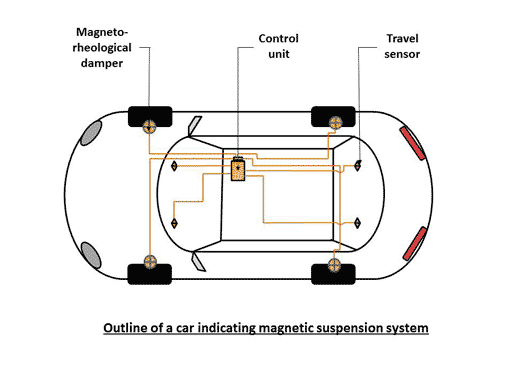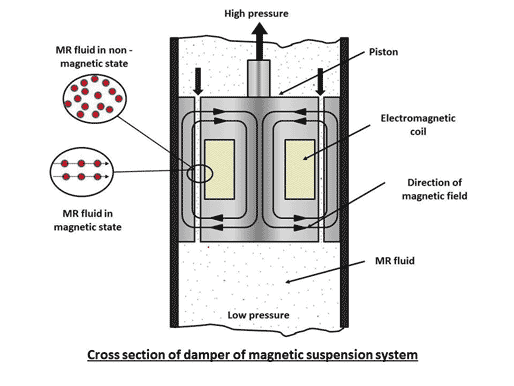Magnetic Suspension System
by Akshay Shinde, CU-ICAR Graduate Student
- Basic Description
-
Magnetic suspension systems are an alternative automotive suspension system that utilizes magnetically controlled dampers, or shock absorbers, for a highly adaptive smooth ride. The absence of mechanical valves and small moving parts makes this type of suspension resistant to wear. Magnetic suspension systems generally consist of four monotube dampers with magneto-rheological (MR) fluid, one on each wheel of the vehicle, a sensor set and an ECU (Electronic Control Unit) to control the system.
 
Each of the dampers has a piston containing two electric coils and two small fluid passages through the cross section of piston. The coils are capable of creating a variable magnetic field proportional to the current flowing in them. The shock absorber pistons in the magnetic suspension system do not contain conventional oil, but a magneto-rheological (MR) fluid. MR fluid is a synthetic hydrocarbon oil in which microscopic magnetic particles (3-10 microns) are embedded. When a voltage is applied to the coil in the piston by means of a pulse delivered by a control unit, a magnetic field is created which aligns the magnetic particles in the magnetic fluid in the direction of the magnetic field applied, which is transverse to the direction of flow of the fluid, thus restricting the flow through the piston holes. The response of magnetic suspension system is much faster than conventional adaptive dampers. As it is a continuously adapting system, it can adapt the damping characteristic to the road condition and the driver's gear-shifting habits within fraction of a second. It's useful not only on bad road terrain, but also in high speed cornering, sudden acceleration and braking. The primary disadvantages of existing systems are their relatively high cost and the oil can thicken after continuous use and requires periodic replacement.
The first generation of magnetic suspensions was developed by Delphi Corporation and debuted on the Cadillac Seville STS in the year 2002. Presently the third generation with faster and more compact ECU's are in use. Due to its high cost, magnetic suspensions are currently found only on select sports cars and higher end luxury models.
- Sensors
- Position sensors, acceleration sensors
- Actuators
- Magnetic dampers
- Data Communications
- High-speed CAN bus data communication, electronic control unit (ECU).
- Manufacturers
- BWI, Delphi, LORD
- For More Information
- [1] SCM: Magnetorheological Suspension System, Ferrari web site.
- [2] Acura's Active Damper System, Acura.com
- [3] MagneRide Performance and Challenge, Delphi at Vehicle Dynamics Expo 2008. (pdf)
- [4] MagneRid, Wikipedia.
- [6] New Audi TT - Magnetic Ride, YouTube, May 16, 2007.
- [5] Third Generation Of BWI Magneride Ride Control Technology Debuts In New Range Rover Evoque, automotive-electronicspecifier.com, June 1, 2011.
|

